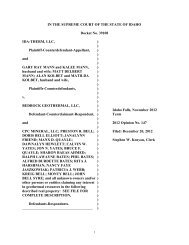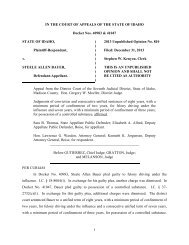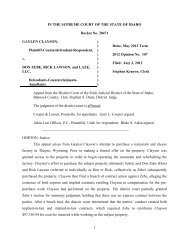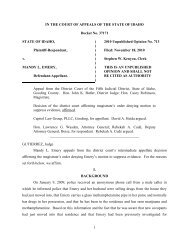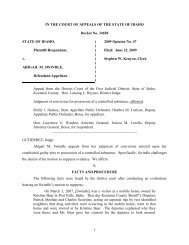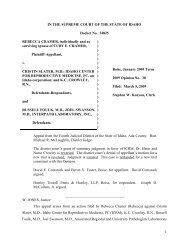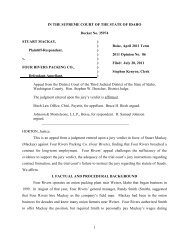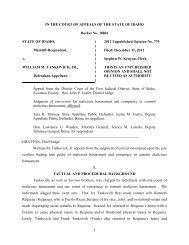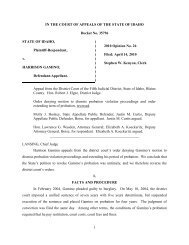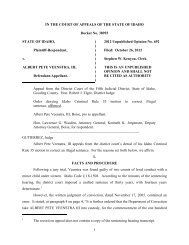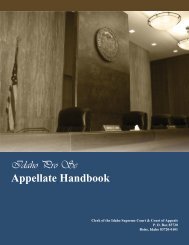April 1, 2013 State v. Hector B. Almaraz, Jr. - Idaho State Judiciary
April 1, 2013 State v. Hector B. Almaraz, Jr. - Idaho State Judiciary
April 1, 2013 State v. Hector B. Almaraz, Jr. - Idaho State Judiciary
Create successful ePaper yourself
Turn your PDF publications into a flip-book with our unique Google optimized e-Paper software.
suggestive identification procedures indicates that self-reported evidence [a witness’s level of<br />
certainty and degree of attention] can be inflated by the suggestive procedure itself”).<br />
In sum, we are not changing the two-part test this Court adopted in Hoisington to<br />
determine whether an out-of-court-identification violates a defendant’s due process rights.<br />
Rather, by outlining the system and estimator variables that research has convincingly shown to<br />
impact the reliability of eye-witness identification, we hope to provide guidance to lower courts<br />
applying the test from Hoisington.<br />
1. The procedures used in obtaining Hust’s pretrial identification were overly<br />
suggestive.<br />
This Court must first determine whether the <strong>State</strong>’s conduct was impermissibly<br />
suggestive. “[T]he due process test for suppression of an in-court identification that is allegedly<br />
tainted by an impermissibly suggestive out-of-court identification is whether the out-of-court<br />
identification was so suggestive that there is a very substantial likelihood of misidentification.”<br />
Hoisington, 104 <strong>Idaho</strong> at 161, 657 P.2d at 25. In accordance with the framework we have just<br />
laid out, our analysis of whether the procedures Officer Sloan used during Hust’s identification<br />
were overly suggestive will include consideration of whether any of the system variables that<br />
diminish the chance of misidentification, such as double-blind administration or proper preidentification<br />
instructions, were present.<br />
It is clear from the facts the police violated the standard guidelines for preparing a photo<br />
lineup by choosing a picture that was overly suggestive in nature. When asked about the proper<br />
procedures used to prepare a photo lineup, Officer Sloan testified that he typically asks the<br />
department’s secretary for a lineup after giving her the suspect’s name. The DMV then provides<br />
the photos using other individuals with similar race, weight, and height, within a couple of hours<br />
from the request. Far from a double-blind administration of a line-up, Officer Sloan was<br />
involved in the case and used a single photograph that pictured <strong>Almaraz</strong> in the center of a group<br />
of individuals. Officer Sloan provided no explanation or justification for using the group<br />
photograph as the photo lineup for Hust’s identification. 9 Furthermore, the police had time—<br />
three days—and the ability to arrange a traditional photo lineup.<br />
9 The defense asked “[c]an you explain why you wouldn’t have used a photo lineup for that rather than a group<br />
picture that you obtained?” Officer Sloan answered “I can’t explain that at this time. I mean, the picture was there,<br />
and I just showed it to Mr. Hust and went from there.”<br />
12



